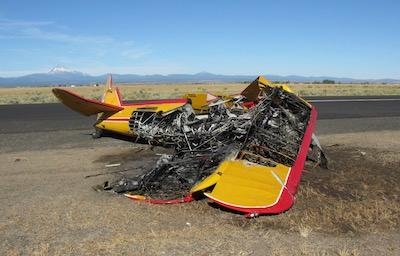Fri, Aug 17, 2018
Cites Pilot Error During Low-Level Maneuver
The NTSB has released its probable cause report from an accident which occurred August 27, 2016 that fatally injured airshow performer Marcus Paine during the Cascades Airshow in Madras in Oregon.

According to the report, Paine was attempting to perform an inside loop immediately after takeoff in his Stearman as part of his performance. He had successfully accomplished the maneuver the previous day, as well as at many previous air shows. Witnesses observed the airplane lift off the runway and remain in a level attitude just above the runway surface before it climbed to perform the loop.
Witnesses reported that the airplane descended from the top of the loop to a point in which its pitch attitude was between 10° and 20° nose-down until it impacted the runway. Video footage of the accident indicated that the pilot was in control of the airplane throughout the maneuver, and postaccident examination revealed no evidence of a preimpact mechanical malfunction or failure that would have precluded normal operation.
Another performer at the airshow reported that, during the evening practice the day before the accident, he observed the pilot perform the same maneuver, and described it as "sketchy" because of the low altitude at which the pilot completed the loop. He added that he previously asked the pilot how to perform this maneuver and the pilot said that it was a "complete crapshoot"; at the top of the loop, the pilot would decide whether he would "pull through and continue the loop or rollout into a half-Cuban or an Immelmann," both of which are recovery aerobatic maneuvers.
Prior to takeoff, the Air Boss reported to the pilot a density altitude (DA) of 4,600 ft. Postaccident calculations revealed that the DA at the time of the accident was about 5,221 ft, both of which are well above a standard day. The high density altitude conditions would have degraded the airplane's overall performance, resulting in decreased engine power available and reduced rate of climb. It is likely that the pilot failed to adequately compensate for the changes in airplane performance due to the high density altitude conditions, which resulted in a collision with terrain.
The NTSB determined the probable cause(s) of this accident to be the pilot's failure to maintain clearance from the runway during a low-level aerobatic maneuver. Contributing to the accident was a high density altitude and the pilot's failure to plan/adequately compensate for high density altitude conditions.
(Image from NTSB accident docket)
More News
Aero Linx: International Federation of Airworthiness (IFA) We aim to be the most internationally respected independent authority on the subject of Airworthiness. IFA uniquely combi>[...]
Ultrahigh Frequency (UHF) The frequency band between 300 and 3,000 MHz. The bank of radio frequencies used for military air/ground voice communications. In some instances this may >[...]
A Few Questions AND Answers To Help You Get MORE Out of ANN! 1) I forgot my password. How do I find it? 1) Easy... click here and give us your e-mail address--we'll send it to you >[...]
From 2019 (YouTube Edition): Learning To Paint Without Getting Any On Your Hands PPG's Aerospace Coatings Academy is a tool designed to teach everything one needs to know about all>[...]
Also: Sustainable Aircraft Test Put Aside, More Falcon 9 Ops, Wyoming ANG Rescue, Oreo Cookie Into Orbit Joby Aviation has reason to celebrate, recently completing its first full t>[...]
 ANN's Daily Aero-Linx (05.06.25)
ANN's Daily Aero-Linx (05.06.25) ANN's Daily Aero-Term (05.06.25): Ultrahigh Frequency (UHF)
ANN's Daily Aero-Term (05.06.25): Ultrahigh Frequency (UHF) ANN FAQ: Q&A 101
ANN FAQ: Q&A 101 Classic Aero-TV: Virtual Reality Painting--PPG Leverages Technology for Training
Classic Aero-TV: Virtual Reality Painting--PPG Leverages Technology for Training Airborne 05.02.25: Joby Crewed Milestone, Diamond Club, Canadian Pilot Insurance
Airborne 05.02.25: Joby Crewed Milestone, Diamond Club, Canadian Pilot Insurance



